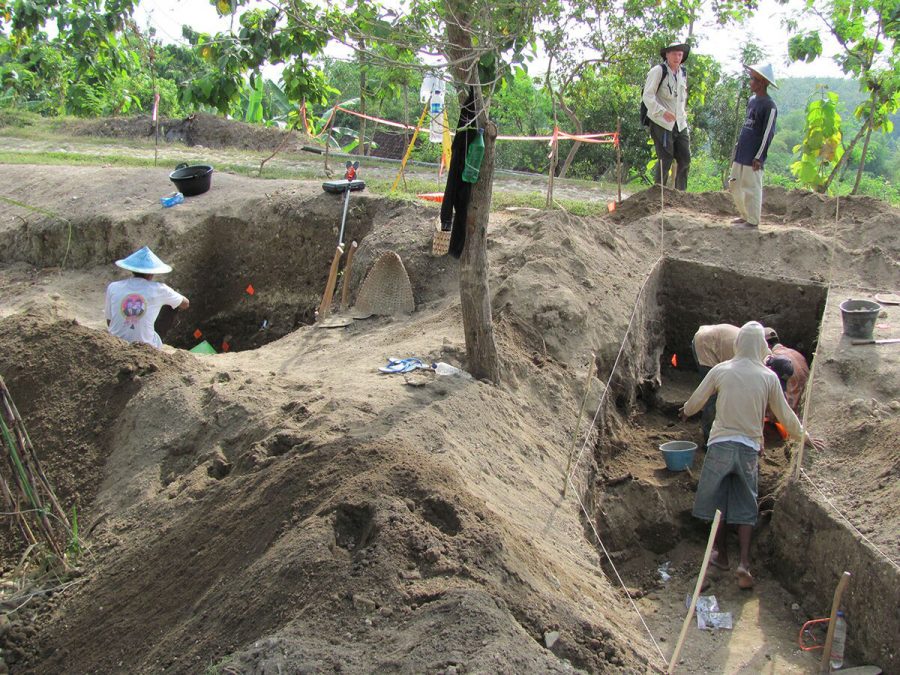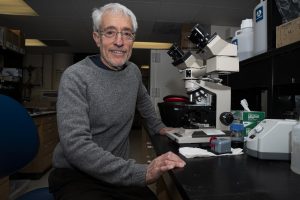UI researcher, international team date the age of Homo erectus settlement
University of Iowa paleoanthropologist Russell worked with an international team of researchers to date the last known settlement of Homo erectus, on the Indonesian island of Java, called Ngandong.
January 28, 2020
After years of uncertainty, University of Iowa paleoanthropologist Russell Ciochon and an international team of researchers are rectifying the age of chronology at the ancient settlement of Ngandong. The site is the last known settlement of Homo erectus, the direct ancestors of modern humans.
Ciochon’s research indicates the extinction of Homo erectus most likely occurred at Ngandong, located on the Indonesian island of Java, because of climate change in the region that transformed dry, woodland environment into rainforest. However, controversy surrounding the site of the extinction concerned the chronology, or the estimated timeframe that the extinction occurred, Ciochon said.
Previous attempts to date the site began in the 1930s, when dating methods were limited, and have since been either inconclusive, unable to yield estimates, or suggestive that the timing of Homo erectus overlapped with that of modern humans, Ciochon said.
“The original excavation occurred before even radiocarbon and uranium series dating were developed,” Ciochon said. “At that time, sites were dated based on relative dating methods such as comparing fauna to other sites on Java and across Asia. From the relative dating, they were able to determine that Ngandong was the youngest site, but not how much younger.”
Ciochon’s research into human evolution on Java started because of its abundance of Homo erectus fossils and other datable material. He initially worked on the oldest Homo erectus site on Java at Sangira and then began his research project involving Ngandong in 2006. His team started excavations in 2008 and continued them in 2010.
Ciochon emphasized the importance of involving two of his UI graduate students, Maija E. Sipola and Shelby Putt, in his last excavation of Ngandong.
Putt, now an assistant professor of anthropology at Illinois State University, said in an email to The Daily Iowan that during her time on Java she supervised a unit of the excavation, removed fossils from the bone bed, and was responsible for digitally mapping the site and fossils.
“I am very happy that I had the opportunity to work at Ngandong because it had given me some key insights into human paleontological research that I am now able to share with my own students,” she said. “While working in Indonesia may not have shaped my career ultimately, it was an eye-opening experience and has influenced how I live my life.”
Related: UI in on new species
Geochronologist Kira Westaway from Macquarie University in Sydney, Australia was also on Java in 2008, but missed Ciochon’s team at Ngandong by a few weeks.
The pair eventually met and combined their research projects in 2014 when each realized that the other had conclusive data on components they found inconclusive or lacking in their own research, Westaway said.
“We knew that if we were going to nail the site, it wouldn’t only take a long time to do, but also we had to try a completely different approach than what had been tried before,” Westaway said. “Everything that had been tried before had been kind of scraping close to the edge but not really nailing it, so we really focused on not just the site itself but tried to look at it as a component of a wider landscape.”
The team dated the site of Ngandong and the surrounding river terraces using uranium-series dating, luminescence, 40argon/39argon, and uranium series-electron-spin resonance, Ciochon said. They combined the results from these different methods using Bayesian modeling, he said.
Their study concluded that Ngandong was the youngest known Homo erectus site in the world, and that the age of the fossils found at the site are from 117,000 to 108,000 years ago, Ciochon said.
“Homo erectus is a very key ancestor. It sits at the base of evolution and is the mother lineage to all that came later,” he said. “That’s why knowing that Homo erectus persisted is important because it gives us an early ancestor and shows us where we came from.”






